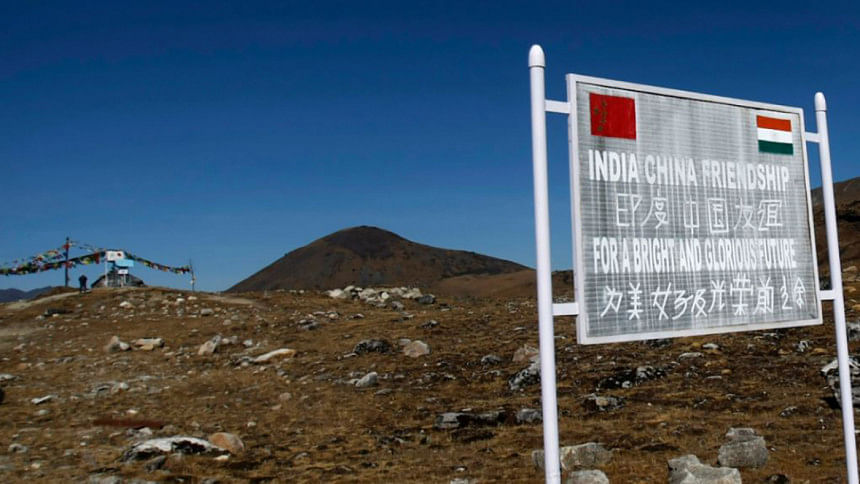What is straining India’s relationship with China and Nepal?

India's relations with two of its northern neighbours China and Nepal have of late come under considerable strain over territorial disputes.
The militaries of India and China were involved in a series of skirmishes, including hand-to-hand combat, first at Naku La on the north eastern Indian state of Sikkim and China's Tibet, in the eastern Himalayas and then at the picturesque Pangong Lake, Demchok and Galwan Valley in Ladakh in the western Himalayas on May 5 and 6.
Both India and China have fortified their positions at the disputed points in the western Himalayas by rushing additional troops and pitching tents at a few stretches.
India feels China had "aggressively blocked" patrolling by the Indian army and construction of short connecting roads on the northern bank of Pangong Lake and near Galwan river which New Delhi claims are "well within Indian territory" and more than 100km apart.
The roads are strategically crucial for India as they lead up to Daulat Beg Oldie, a key Indian Air Force base in Ladakh.
On the other hand, China's People's Liberation Army (PLA) is also engaged in major construction at its airbase just about 200km from Pangong Lake and deployed combat jets there, Indian media outlets reported showing satellite images.
Amidst the escalating tensions between India and China, Indian Army Chief Gen M Naravane reportedly visited Ladakh last Friday to assess the operational situation along the unresolved border with China.
This was not the first time the border skirmishes between Indian and Chinese armies took place as they had occurred a few times in the past few years. One has just to recall the 73-day eyeball-to-eyeball faceoff between the two armies at Doklam on the tri-junction of India-China-Bhutan border that was finally resolved through diplomatic channels in 2017.
There is recognition in the establishment in New Delhi that border skirmishes often erupt in an area on account of difference in perception between the two sides of the alignment of the de jure border and that the two sides have established mechanisms to resolve such situations through talks.
Since Indian Prime Minister Narendra Modi and Chinese President Xi Jingping have invested considerable political and diplomatic capital in bilateral ties since the Doklam confrontation by holding two informal summits in Wuhan in 2018 and in Chennai the following year, direct top-level politico-diplomatic intervention appears likely this time around to defuse the ongoing tensions.
On May 26, Modi had separate meetings with his National Security Adviser Ajit K Doval, Chief of Defence Staff Gen Bipin C Rawat and External Affairs Minister S Jaishankar to discuss the situation at the Sino-India border.
Most analysts in New Delhi believe that China's actions on the border have been prompted by two factors: one, to send a message to India that it should not join the United States' campaign for an international probe into China's handling of Covid-19 virus and that New Delhi should not back Taiwan's bid to get back observer status in the World Health Organization.
India's recent decision to stop automatic government clearance to Chinese investments in India post-Covid-19 pandemic has also not gone down well in Beijing, analysts point out.
THE NEPAL ISSUE
Even as Indian and Chinese troops remain in direct face-off, India's ties with Nepal have nosedived to a new low with a standoff over territory.
The spat between New Delhi and Kathmandu began over Nepal Prime Minister Khadga Prasad Sharma Oli's protest against the inauguration of a new road by Indian Defence Minister Rajnath Singh, built on a shorter pre-existing route to Hindu pilgrimage centre Kailash Mansoravar in Tibet, to Lipulekh in the northern Indian state of Uttarakhand.
Hitting back, Oli released a new map of the area claiming Lipulekh and Kalapani to be in Nepal's territory and said the "Indian virus appears to be more dangerous than Chinese virus." Oli cited a 1997 joint statement by India and Nepal to claim that this boundary issue had been on the bilateral agenda for over two decades.
India reacted sharply to Oli's releasing a new map. The Indian External Affairs Ministry spokesperson Anurag Srivastava said the "unilateral act" of including parts of Indian territory in a revised official map of Nepal "is not based on historical facts and evidence, is contrary to the bilateral understanding to resolve the outstanding boundary issues through diplomatic dialogue and that such artificial enlargement of territorial claims will not be accepted by India."
India had released a map in November last year showing Lipulekh Pass part of its territory, a move that had drawn Nepal's ire at that time. The inauguration of the pilgrimage route through Lipulekh had sparked street protests in Kathmandu earlier this month.
The reading in New Delhi, as reflected in India's former foreign secretary and former ambassador to Nepal Shyam Saran's remarks in a newspaper interview, is that Oli is trying to deflect the attention in his home from turmoil in his ruling alliance in which his rival in the Communist Party of Nepal Madhav Kumar Nepal and Maoist leader Pushpa Kumar Dahal are reportedly trying to topple him.

 For all latest news, follow The Daily Star's Google News channel.
For all latest news, follow The Daily Star's Google News channel. 



Comments